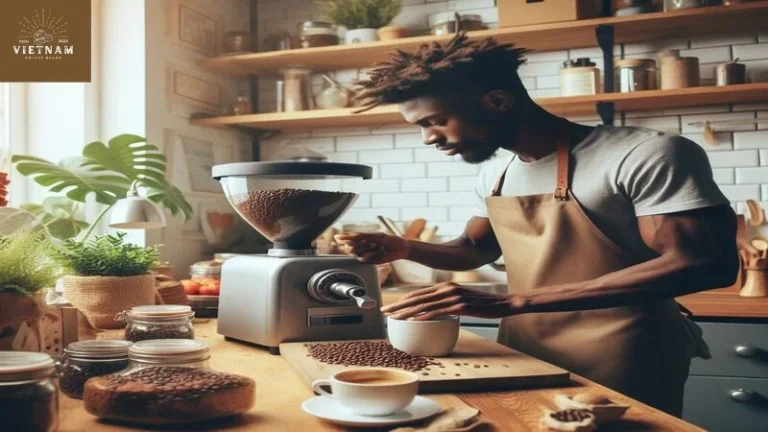Picture this: you’re sitting in a bustling café in Hanoi, Vietnam, surrounded by the rich aroma of freshly brewed coffee. As you take a sip of your steaming cup, you can’t help but be captivated by the unique and robust flavors dancing on your palate. What sets Vietnamese coffee apart from the rest? It’s all about the perfect ratio.
In Vietnamese coffee culture, achieving the ideal balance between coffee and water is crucial to creating that unmistakable taste. Known as the Vietnamese coffee ratio, this precise measurement ensures that every cup is a work of art.
In this article, I will delve into the origins of this and its significance in their culture. We will explore the traditional making method used to achieve perfection and provide tips for mastering this elusive ratio at home. Additionally, we’ll venture into variations and additions that can elevate your Vietnamese coffee experience to new heights.
So grab a seat, prepare your taste buds for an adventure, and let’s uncover the secrets behind the captivating world of this ratios.
Key Takeaways
- It is known for its unique and robust flavors.
- The making method involves slowly dripping hot water over condensed milk and coffee grounds using a small metal filter called a phin.
- The perfect coffee to water ratio is crucial in Vietnamese coffee culture and can be adjusted to achieve different flavor profiles.
- It offers endless possibilities for variations and additions, such as adding condensed milk, coconut milk, or infusing spices for warmth and complexity.
The Origins of Vietnamese Coffee

To understand the origins, you must delve into the rich history and cultural significance that it holds. Vietnam has a long-standing tradition of coffee production, dating back to the 19th century when French colonists introduced coffee cultivation to the country.
The Vietnamese phin coffee guide is an essential tool for brewing Vietnamese coffee correctly.
Over time, coffee became deeply ingrained in Vietnamese culture and played a vital role in daily life. Today, Vietnam is one of the largest exporters of coffee in the world.
The unique aspect lies in its preparation method and flavor profile. Traditionally prepared using a small metal filter called a phin, this is brewed slowly over condensed milk, resulting in a rich and intense cup of joe. This making technique showcases the influence of French colonialism on Vietnamese cuisine.
It has gained international recognition for its strong taste, distinct aroma, and smooth texture. It continues to be an integral part of Vietnamese culture and represents the nation’s historical ties with France as well as its own unique identity.
The Importance of the Coffee to Water Ratio

Much like other brewing techniques, the science of coffee water ratio applies to this unique coffee style.
The coffee to water ratio is an essential factor in making a delicious cup. Using the right amount of coffee and water can make all the difference in the taste and strength of your brew.
Whether you’re making iced coffee with a phin coffee filter or drip coffee with a coffee maker, it’s important to measure your ingredients carefully. For a traditional Vietnamese iced coffee ( see how to measure iced coffee ratio ), you’ll need sweetened condensed milk, ice, and Nguyen coffee. The key is to experiment and find the perfect balance that suits your taste.
Make sure you’ve got the right balance between your water and grounds – it’s what truly sets your brew apart. When it comes to Vietnamese coffee, the coffee to water ratio is of utmost importance. Making techniques vary depending on the desired flavor profile of the coffee.
For a stronger, more intense flavor, a higher ratio of coffee grounds to water is recommended. On the other hand, if you prefer a milder taste, a lower ratio should be used. Additionally, the quality of the coffee beans plays a significant role in determining the ideal ratio.
Higher-quality beans tend to have more complex flavors and aromas, allowing for a greater concentration without overpowering bitterness. Experimentation with different ratios is key to finding that perfect cup that suits your taste preferences.
The Traditional Vietnamese Coffee Brewing Method

Get ready to experience the authentic taste of Vietnam with this traditional making method that will transport you to the bustling streets of Hanoi. The traditional Vietnamese coffee making method is known for its unique and delicious flavor.
It involves using a special filter called a phin, which is placed on top of a cup or glass. A small amount of condensed milk is added to the bottom of the cup, followed by finely ground coffee. Hot water is then poured into the phin, allowing it to slowly drip through the grounds and mix with the condensed milk.
This process creates a rich and smooth coffee with a hint of sweetness from the milk. When it comes to choosing coffee beans for this method, there are different options available such as Robusta or Arabica beans, each offering their own distinct flavors and characteristics.
So go ahead, try out this traditional making technique and savor every sip of your authentic Vietnamese coffee experience.
There another coffee has name Cowboy, you may interesting with it, check what you need to know about cowboy coffee for more information.
Tips for Achieving the Perfect Vietnamese Coffee Ratio
Achieving the perfect balance is key when making traditional Vietnamese coffee; finding the right amount of condensed milk and finely ground beans will ensure a delightful and flavorful cup every time.
To achieve consistency in your brew, it is important to experiment with different beans and adjust the coffee-to-water ratio to suit your taste preferences.
Here are some tips to help you find that perfect Vietnamese coffee ratio:
- Start with a 1:2 ratio of coffee to water. This means using 1 tablespoon of ground coffee for every 2 tablespoons of water.
- If you prefer a stronger brew, increase the amount of coffee while keeping the same water measurement.
- For a milder taste, decrease the amount of coffee accordingly.
- Remember that personal preference plays a big role in determining the ideal ratio, so don’t be afraid to adjust it until you find what works best for you.
By following these tips and experimenting with different beans, you can achieve the perfect ratio that suits your taste buds and ensures a consistently delicious cup every time.
Exploring Variations and Additions to Vietnamese Phin Coffee
Indulging in the vibrant flavors of Vietnam’s beloved beverage, one can explore a myriad of delightful variations and tantalizing additions to elevate their coffee experience. Vietnamese coffee is known for its strong and bold taste, but there are endless possibilities when it comes to experimenting with different flavors and unique coffee blends.
One popular variation is adding condensed milk to create a creamy and sweet twist on the traditional brew. For those who prefer a lighter flavor, coconut milk can be used instead. Another option is to infuse the coffee with spices like cinnamon or cardamom for a touch of warmth and complexity.
Some even enjoy blending Vietnamese coffee with chocolate or caramel for an indulgent treat. The possibilities are truly endless when it comes to exploring the world of Vietnamese coffee flavors and creating your own signature blend.
Frequently Asked Questions
Conclusion
In conclusion, mastering the art of the Vietnamese coffee ratio is key to experiencing the true essence of this beloved beverage. Just like a symphony conductor skillfully blends different musical elements, achieving the perfect balance between coffee and water creates a harmonious and rich flavor profile.
By following traditional brewing methods and experimenting with variations, you can unlock a world of aromatic delights that will transport your taste buds to the bustling streets of Vietnam. So go ahead, indulge in this caffeinated adventure and savor every sip like a true connoisseur.
You may want to try the coffee has name Cowboy, we have an article about cowboy coffee ratio and brewing method for you from our website.
And if you’re a fan of dalgona coffee, you may want to learn about what you need for dalgona coffee so you can make your own coffee.
Hope you get useful information from the article, If you want to read other article or want to read more about coffeebeans, please visit the website: vietnamcoffeebeans.com
Thank you!






